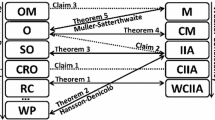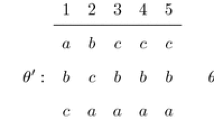Abstract
This paper re-examines the classic impossibility results of Arrow (J Polit Econ 58(4):328–346, 1950) and Sen (J Polit Econ 78:152–157, 1970) with preferences replaced by choice functions that satisfy Weak WARP. In particular, both social and individual choices can be as in bounded rationality models of categorization, inattention or psychological constraints. A simple delegation rule that assigns a social decider to each choice satisfies Arrow’s desiderata. In addition, and in direct contrast with central ideas in economics, social choices can be ordered when all individual choice functions are anomalous. Finally, no delegation rule can be liberal [in a formal sense akin to the definition in Sen 1970], satisfy independence of irrelevant alternatives and map Weak WARP individual choice functions into Weak WARP social choice functions.
Similar content being viewed by others
Notes
Our definition of liberalism is formally related to Sen’s definition and so we adopt Sen’s concept and terminology. However, unlike Sen, we do not use liberalism to capture an idea of individual rights. Instead, liberalism is used to define delegation rules with stronger non-dictatorial qualities than the moderated delegation rule. In a liberal delegation rule, any agent can be the social decider, regardless of their choices.
References
Aizerman M, Aleskerov F (1986) Voting operators in the space of choice functions. Math Soc Sci 11:201–242
Aizerman M, Aleskerov F (1995) Theory of choice in studies in mathematical and managerial economics, volume 38. In: Gleiser H, Martin S (eds) North-Holland Elsevier Science B.V.
Aleskerov F (2002) Categories of Arrovian voting schemes chapter 2. In: Arrow K, Sen A, Suzumura K (eds) Handbook of Social Choice and Welfare, volume 1. North-Holland Elsevier Science B.V., pp 95–129
Aleskerov F (2010) Arrovian aggegation models in studies B: mathematical and statistical methods, vol 39. In: Leinfellner W, Eberlein G (eds) Kluwer Academic Publishers, Norwell
Arrow K (1950) A difficulty in the concept of social welfare. J Polit Econ 58(4):328–346
Bossert W, Suzumura K (2010) Consistency, choice and rationality. Harvard University Press, Cambridge
Charness S (2012) Groups make better self-interested decisions. J Econ Perspect 26(3):157–176
Cherepanov V, Feddersen T, Sandroni A (2013) Rationalization. Theor Econ 8–3:775–800
Ehlers L, Sprumont Y (2008) Weakened warp and top-cycle choice rules. J Math Econ 44:87–94
Gaertner W, Pattanaik P, Suzumura K (1992) Individual rights revisited. Economica 59:161–177
Ju B (2013) On the characterization of liberalism by Samet and Schmeidler. Soc Choice Welf 40:359–366
Lleras J, Masatlioglu Y, Nakajima D, Ozbay E (2017) When more is less: limited consideration. J Econ Theory 170:70–85
Manzini P, Mariotti M (2007) Sequentially rationalizable choice. Am Econ Rev 97–5:1824–1839
Manzini P, Mariotti M (2012) Categorize then choose: boundedly rational choice and welfare. J Eur Econ Assoc 10(5):1141–1165
Masatlioglu Y, Nakajima D, Ozbay E (2012) Revealed attention. Am Econ Rev 102(5):2138–2205
Nozick R (1974) Anarchy State and Utopia. Basil Blackwell, Oxford
Samet D, Schmeidler D (2003) Between liberalism and democracy. J Econ Theory 110:213–233
Sen A (1970) The impossibility of a Paretian Liberal. J Polit Econ 78:152–157
Sugden R (1985) Liberty, preference and choice. Econ Philos 1:185–205
Suzumura K (2011) Welfarism, individual rights and procedural justice. In: Arrow K, Sen A, Suzumura K (eds) Handbook of social choice and welfare, vol II. Elsevier Science B.V., North-Holland, Amsterdan
Author information
Authors and Affiliations
Corresponding author
Additional information
We thank the guest editor, Professor Kotaro Suzumura, and two anonymous referees for excellent comments and suggestions.
Appendix
Appendix
Lemma 1
Assume that there are at least four options different options x, y, z and w. There exists a choice function C that satisfies Weak WARP and any of the properties below
Proof
Assume, by contradiction, that there is a violation of Weak WARP on
So, \(C(\{x_{1},y_{1}\})=C(B_{1}^{*})=x_{1}\), and \(C(B_{1})=y_{1}\ne x_{1}\).
For (6.1), consider an order that places z as the last alternative, y above x and w above x. Consider a choice function such that \(C(x,y)=x\), \(C(A)=z\) and for any other issue B, C maximizes this order on B. If \(B_{1}^{*}=A\) then \(x_{1}=z\) and \( C(\{x_{1},y_{1}\})=z\) but this is impossible because z is not chosen by C in any binary choice. So, \(B_{1}^{*}\ne A\). Then, C chooses on \(B_{1}\) and \(B_{1}^{*}\) by maximizing the same order. So, there can be no violation of WARP on \(B_{1}\subset B_{1}^{*}\). Thus, there is no violation of Weak WARP.
For (6.2), consider an order that places y as the last alternative, and w as the second last alternative and x as the third last alternative. Consider a choice function such that \(C(x,y,w)=C(A)=y\) and for any other issue B, C maximizes this order on B. Now \(B_{1}^{*}\ne A\) because y is not chosen by C in any binary choice. It follows that \(B_{1}=(x,y,w)\) because C maximizes the same order on \(B_{1}\ne \{x,y,w\}\) and \(B_{1}^{*}\ne A.\) Thus, \(y_{1}=y\) and \(x_{1}\in \{x,w\}.\) So, \(C(B_{1}^{*})\in \{x,w\},\) but this is impossible because \( B_{1}^{*}\) must have at least four alternatives.
For (6.3), consider an order that places z as the last alternative, y above x and x above w. The proof now follows the same argument as in the proof of (6.1).
For (6.4), consider an order that places x as the last alternative, and y as the second last option. Consider a choice function such that \(C(x,y)=\)\(C(A)=x\) and for any other issue B, C maximizes this order on B. If \(B_{1}^{*}=A\) then \(\{x_{1},y_{1}\}=\{x,y\}\) (because \( C(\{x_{1},y_{1}\})=x\) and x is not chosen by C in any binary choice other than \(\{x,y\})\). It follows that \(x_{1}=x\) and \(y_{1}=y\). But \( C(B_{1})=y\) is impossible because \(B_{1}\) has at least three alternatives. So, \(B_{1}^{*}\ne A\). Then, C chooses on \(B_{1}\) and \(B_{1}^{*}\) by maximizing the same order. So, there can be no violation of WARP on \( B_{1}\subset B_{1}^{*}\). Thus, there is no violation of Weak WARP. \(\square \)
Lemma 2
Assume that there are at least four options different options x, y, z and w. If \(\varphi \) is a delegation rule that satisfies IIA and Weak WARP-consistency then there is an agent \(i\in \{1,2\}\) such that \(C_{\varphi }(B)=C_{i}(B)\) for every binary issue B.
Proof
Assume, by contradiction, that there are two issues \(\{x,y\}\) and \(\{z,w\}\) and choice functions \((C_{1},C_{2},C_{\varphi })\) such that
and
\(\square \)
We can consider two cases. (1) There is no overlap between \(\{x,y\}\) and \( \{z,w\}\) and so all four options \(\{x,y,z,w\}\) are different. (2) there is an overlap between \(\{x,y\}\) and \(\{z,w\}\) and so we can assume, without loss of generality that \(z=y\) and all three options \(\{x,y,z\}\) are different.
Case 1 We can assume, without loss of generality, that \(C_{1}(\{x,y\})=x\) and \(C_{2}(\{z,w\})=z,\) (the proof remains exactly the same for any other choices). By Lemma 1, (6.1), there are choice functions \({\tilde{C}} _{1}\) and \({\tilde{C}}_{2}\) that satisfy Weak WARP such that
(where the second equation obtains replacing x and z and y and w). By IIA,
Given that \(\varphi \) is a delegation rule,
If \({\tilde{C}}_{\varphi }(A)=x\) then \({\tilde{C}}_{\varphi }\) violates Weak WARP on \(\{x,y\}\subset \{x,y,z\}\subset A\).
If \({\tilde{C}}_{\varphi }(A)=z\) then \({\tilde{C}}_{\varphi }\) violates Weak WARP on \(\{z,w\}\subset \{x,z,w\}\subset A\).
Case 2 is now divided into three subcases. (2a) 1 chooses the non-overlapping option x and 2 chooses the overlapping option y. (2b) 1 chooses the non-overlapping option x and 2 also chooses the non-overlapping option z. (2c) 1 and 2 choose the overlapping option y. The case where 1 chooses the overlapping option y and 2 chooses the non-overlapping option z is analogous to 2a and, hence, omitted.
Case 2a By Lemma 1, (6.2), there is a choice functions \( {\tilde{C}}_{1}\) that satisfy Weak WARP such that
By Lemma 1, (6.3), there is a choice functions \({\tilde{C}}_{2}\) that satisfy Weak WARP such that
(replacing x with y, y with z and z with x). By IIA,
Given that \(\varphi \) is a delegation rule,
If \({\tilde{C}}_{\varphi }(A)=x\) then \({\tilde{C}}_{\varphi }\) violates Weak WARP on \(\{x,y\}\subset \{x,y,w\}\subset A\).
If \({\tilde{C}}_{\varphi }(A)=y\) then \({\tilde{C}}_{\varphi }\) violates Weak WARP on \(\{y,z\}\subset \{w,y,z\}\subset A\).
Case 2b By Lemma 1, (6.1), there are choice functions \({\tilde{C}} _{1}\) and \({\tilde{C}}_{2}\) that satisfy Weak WARP such that
(where the second equation obtains replacing x and z). By IIA,
Given that \(\varphi \) is a delegation rule,
If \({\tilde{C}}_{\varphi }(A)=x\) then \({\tilde{C}}_{\varphi }\) violates Weak WARP on \(\{x,y\}\subset \{x,y,z\}\subset A\).
If \({\tilde{C}}_{\varphi }(A)=z\) then \({\tilde{C}}_{\varphi }\) violates Weak WARP on \(\{y,z\}\subset \{x,y,z\}\subset A\).
Case 2c By Lemma 1, (6.4), there are choice functions \({\tilde{C}} _{1}\) and \({\tilde{C}}_{2}\) that satisfy Weak WARP such that
(where the first equation obtains replacing x and y and the second equation obtains replacing x with y, y with z and z with x). By IIA,
Given that \(\varphi \) is a delegation rule,
If \({\tilde{C}}_{\varphi }(\{x,y,z\})=x\) then \({\tilde{C}}_{\varphi }\) violates Weak WARP on \(\{x,y\}\subset \{x,y,z\}\subset A\).
If \({\tilde{C}}_{\varphi }(\{x,y,z\})=z\) then \({\tilde{C}}_{\varphi }\) violates Weak WARP on \(\{y,z\}\subset \{x,y,z\}\subset A\).
1.1 Proof of Theorem 1
Fix an issue \(B\in {\mathcal {B}}\). Assume that \(C_{1}\) and \({\tilde{C}}_{1}\) are B-equivalent and \(C_{2}(B)={\tilde{C}}_{2}(B)\). By definition, whether a choice is \(B-\)anomalous for 1 depends only on the choices that 1 makes involving alternatives in B. So, \({\bar{\varphi }}(C_{1},C_{2},B)=2\) if and only if \({\bar{\varphi }}({\tilde{C}}_{1},{\tilde{C}}_{2},B)=2\) and, hence, \(\bar{ \varphi }\) satisfies IIA.
Now assume that \(C_{{\bar{\varphi }}}\) does not satisfy Weak WARP. Then, there are issues and alternatives such that \(x\ne y,\)\(\{x,y\}\subseteq B_{1}\subseteq B_{2},\)\(C_{{\bar{\varphi }}}(\{x,y\})=C_{{\bar{\varphi }} }(B_{2})=x \) and \(C_{{\bar{\varphi }}}(B_{1})=y\). By definition, \( C_{1}(\{x,y\})=C_{{\bar{\varphi }}}(\{x,y\})=x\) (because no alternative is \( \{x,y\}\)-anomalous for 1). So, \(y\in B_{1}\) is \(B_{1}\)-anomalous for 1. Thus, if \(C_{2}(B_{1})=y\) then \({\bar{\varphi }}(B_{1},C_{1},C_{2})=1\) and so, \( C_{1}(B_{1})=C_{{\bar{\varphi }}}(B_{1}).\) If \(C_{2}(B_{1})\ne y\) then \( C_{1}(B_{1})=C_{{\bar{\varphi }}}(B_{1})\). Thus, \(C_{1}(B_{1})=C_{{\bar{\varphi }} }(B_{1})=y.\) If follows that \(x\in B_{2}\) is \(B_{2}\)-anomalous for 1. By the same argument, \(C_{1}(B_{2})=C_{{\bar{\varphi }}}(B_{2})=x\). Hence, \(C_{1}\) violates Weak WARP. So, \({\bar{\varphi }}\) satisfies Weak WARP consistency. The non-dictatorial property of \({\bar{\varphi }}\) is shown by Example 1.
1.2 Proof of Theorem 2
By Lemma 2, we can assume, without loss of generality that \(C_{\varphi }(B)=C_{1}(B)\) for every binary issue B. Let \({\bar{B}}\) be an issue such that \(\varphi ({\bar{B}},C_{1},C_{2})=2\) for every choice function \(C_{1}\). The issue \({\bar{B}}\) is not binary and so, contains at least three options. Take any two options x and y in \({\bar{B}}\). First consider the case where \({\bar{B}}\ne A\) and choice functions (that satisfy Weak WARP) such that \( C_{1}(x,y)=C_{1}(A)=x\) and \(C_{2}({\bar{B}})=C_{2}(A)=y\) (see Lemma 1, (6.2), for existence of function \(C_{1}\). For the existence of function \(C_{2},\) just assume that 2 maximizes a single order that places y at the top.) So, \(C_{\varphi }(x,y)=C_{\varphi }(A)=x\) and \(C_{\varphi }( {\bar{B}})=y\). Thus, \(\varphi \) is not Weak WARP consistent. Now consider the case where \({\bar{B}}=A\) and choice functions (that satisfy Weak WARP) such that \(C_{1}(x,y)=x,\)\(C_{1}(x,y,z)=C_{2}(x,y,z)=y\) and \(C_{2}(A)=x\) (see Lemma 1, (6.2), for the existence of \(C_{1}\) and Lemma 1, (6.4), replacing z with x and w with z, for the existence of \( C_{2}\)). So, \(C_{\varphi }(x,y)=C_{\varphi }(A)=x\) and \(C_{\varphi }(x,y,z)=y \). Thus, \(\varphi \) is not Weak WARP consistent.
1.3 Proof of the Claims on section “Extension ton-agents”
It is straightforward to show that \({\bar{\varphi }}\) satisfies Minimum Participation for all. Take example 1 and define arbitrarily choices that involves any option other than x, y and z. Given agent \(i\ne 1\), consider the profile of individual choice functions such that the choices of i are the choices of agent 2 in example 1 and the choices of all agents \( j\ne i\) are the choices of agent 1 in example 1. So, \(i\ne 1\) is the decider on \(\{x,y,z\}\). For a choice profile where 1 is the decider, consider the profile where the choices of agent 1 remain as in the example and the choices of all other agents are the choices of 2. Then, 1 is the decider on the issue \(\{y,z\}\). The proof that \({\bar{\varphi }}\) satisfies IIA and is Weak WARP-consistent follow the same argument as in Theorem 1.
Rights and permissions
About this article
Cite this article
Katz, L., Sandroni, A. Limits on power and rationality. Soc Choice Welf 54, 507–521 (2020). https://doi.org/10.1007/s00355-018-1160-2
Received:
Accepted:
Published:
Issue Date:
DOI: https://doi.org/10.1007/s00355-018-1160-2




